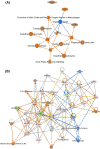Serum proteome of dogs with chronic enteropathy
- PMID: 37186013
- PMCID: PMC10229361
- DOI: 10.1111/jvim.16682
Serum proteome of dogs with chronic enteropathy
Abstract
Background: Chronic enteropathy (CE) is common in dogs and can occur with multiple etiologies including food-responsive enteropathy (FRE) and idiopathic inflammatory bowel disease (IBD).
Hypothesis/objective: To study the protein profile and pathway differences among dogs with FRE, IBD, and healthy controls using serum proteome analysis.
Animals: Nine CE dogs with signs of gastrointestinal disease and histologically confirmed chronic inflammatory enteropathy and 16 healthy controls.
Methods: A cross-sectional study with cases recruited from 2 veterinary hospitals between May 2019 and November 2020 was performed. Serum samples were analyzed using mass spectrometry-based proteomic techniques.
Results: Proteomic profiles showed marked variation in relative protein abundances. Forty-five proteins were significantly (P ≤ .01) differentially expressed among the dogs with CE and controls with ≥2-fold change in abundance. The fold change of dogs with IBD normalized to controls was more pronounced for the majority of proteins than that seen in the dogs with FRE normalized to control dogs. Proteins involving reactive oxygen species, cytokine activation, acute phase response signaling, and lipid metabolism were altered in dogs with CE.
Conclusions and clinical importance: Cytokine alterations, acute phase response signaling, and lipid metabolism are likely involved in pathogenesis of CE. Although there are insufficient current data to justify the use of proteomic biomarkers for assessment of CE in dogs, our study identifies potential candidates.
Keywords: biomarkers; food-responsive enteropathy; inflammatory bowel disease; proteins; proteomics.
© 2023 The Authors. Journal of Veterinary Internal Medicine published by Wiley Periodicals LLC on behalf of American College of Veterinary Internal Medicine.
Conflict of interest statement
Authors declare no conflict of interest.
Figures


Similar articles
-
Serum proteome profiles in cats with chronic enteropathies.J Vet Intern Med. 2023 Jul-Aug;37(4):1358-1367. doi: 10.1111/jvim.16743. Epub 2023 Jun 6. J Vet Intern Med. 2023. PMID: 37279179 Free PMC article.
-
Faecal proteomics in the identification of biomarkers to differentiate canine chronic enteropathies.J Proteomics. 2022 Mar 15;254:104452. doi: 10.1016/j.jprot.2021.104452. Epub 2021 Dec 24. J Proteomics. 2022. PMID: 34958965
-
Blood neutrophil-to-lymphocyte ratio (NLR) as a diagnostic marker in dogs with chronic enteropathy.J Vet Diagn Invest. 2021 May;33(3):516-527. doi: 10.1177/1040638721992057. Epub 2021 Feb 8. J Vet Diagn Invest. 2021. PMID: 33554784 Free PMC article.
-
[Diagnostic and therapeutic approach to chronic inflammatory enteropathies in dogs].Tierarztl Prax Ausg K Kleintiere Heimtiere. 2017 Oct 17;45(5):317-327. doi: 10.15654/TPK-170366. Epub 2017 Sep 21. Tierarztl Prax Ausg K Kleintiere Heimtiere. 2017. PMID: 28933796 Review. German. No abstract available.
-
Dietary management of chronic enteropathy in dogs.J Small Anim Pract. 2022 Jun;63(6):425-434. doi: 10.1111/jsap.13471. Epub 2022 Jan 6. J Small Anim Pract. 2022. PMID: 34991182 Review.
Cited by
-
Flavonoids in mitigating the adverse effects of canine endotoxemia.Front Vet Sci. 2024 Aug 13;11:1396870. doi: 10.3389/fvets.2024.1396870. eCollection 2024. Front Vet Sci. 2024. PMID: 39193369 Free PMC article.
-
Modulation of In Vitro Macrophage Responses via Primary and Secondary Bile Acids in Dogs.Animals (Basel). 2023 Nov 30;13(23):3714. doi: 10.3390/ani13233714. Animals (Basel). 2023. PMID: 38067065 Free PMC article.
-
Properdin, transcortin and HGFAC are novel plasma biomarkers in canine chronic inflammatory enteropathies from active disease to remission.Sci Rep. 2025 Jul 15;15(1):25443. doi: 10.1038/s41598-025-11474-0. Sci Rep. 2025. PMID: 40659816 Free PMC article.
References
-
- Washabau RJ, Day MJ, Willard MD, et al. Endoscopic, biopsy, and histopathologic guidelines for the evaluation of gastrointestinal inflammation in companion animals. J Vet Intern Med. 2010;24:10‐26. - PubMed
-
- Allenspach K, Mochel JP. Current diagnostics for chronic enteropathies in dogs. Vet Clin Pathol. 2022;50(Suppl 1):18‐28. - PubMed
MeSH terms
Substances
Grants and funding
LinkOut - more resources
Full Text Sources

